If my annual tally of plagiarism and fabrication incidents is the depressing part of “Regret the Error”‘s year-end coverage, then this annual collection of the best of the worst in errors and corrections is the highlight.
That’s not to say the mistakes detailed below are minor or purely amusing; many are serious failures.
But it’s important to acknowledge the amusing and outrageous, and to collect them to help journalists avoid making the same mistakes.I also want to celebrate the correction writers who went beyond the call of duty to offer something special.
Here’s the best and most notable of 2012′s media errors and corrections.
I hope you and your colleagues never make the list.
Error of the Year
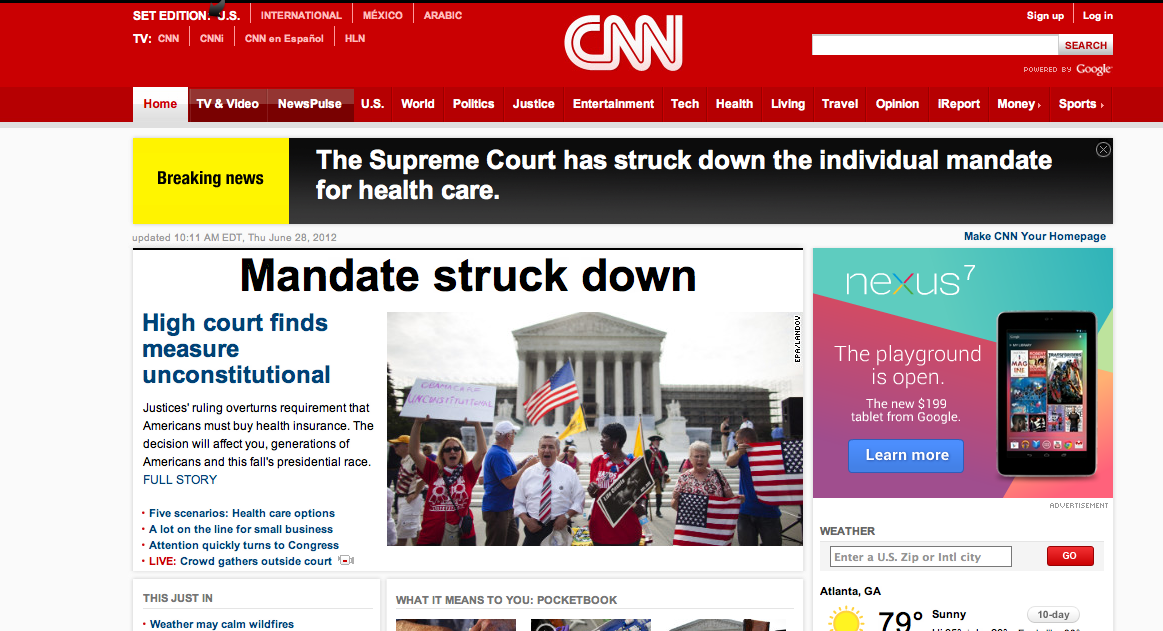
They’re rarely in alignment, but the summer saw CNN and Fox News come together to create the year’s most notable and high profile mistake. Both outlets wrongly interpreted the Supreme Court’s Affordable Care Act decision, declaring that the individual mandate had been struck down.
CNN said it on air, online, by email newsletter, on Twitter. This mistake was platform agnostic, which is one reason why it deserves error of the year status. It’s an example of how an error on a big breaking story can flow quickly, and move seemingly out of control, in a matter of seconds. The SCOTUS error takes the honor, too, because of the high profile nature of the story, and therefore of the mistakes.

There’s another important reason I elevated this to Error of the Year. It relates to what happened after the initial mistake.
After CNN and Fox News were criticized and mocked, they each made public statements.
From CNN:
In his opinion, Chief Justice Roberts initially said that the individual mandate was not a valid exercise of Congressional power under the Commerce Clause. CNN reported that fact, but then wrongly reported that therefore the court struck down the mandate as unconstitutional. However, that was not the whole of the Court’s ruling. CNN regrets that it didn’t wait to report out the full and complete opinion regarding the mandate. We made a correction within a few minutes and apologize for the error.Fox News:
We gave our viewers the news as it happened. When Justice Roberts said, and we read, that the mandate was not valid under the Commerce clause, we reported it. Bill Hemmer even added, be patient as we work through this. Then when we heard and read, that the mandate could be upheld under the government’s power to tax, we reported that as well—all within two minutes.Same mistake made at the same time, and yet only one news outlet apologized.
By contrast, one other cable network was unable to get their Supreme Court reporter to the camera, and said as much. Another said it was a big setback for the President. Fox reported the facts, as they came in.
As Poynter’s Jeff Sonderman explained at the time, “Fox’s statement says it ‘reported the facts’ when in fact Fox, like CNN, misinterpreted the facts. CNN owned its error when it said it leapt from reporting Roberts’ words to ‘therefore the court struck down the mandate as unconstitutional.’ Fox is saying its interpretation was a fact. Not quite.”
CNN demonstrated professionalism by accepting responsibility for its error. It then worked to help spread the correct information. CNN issued corrections via email, Twitter and on TV. If we compare the number of retweets for its errant tweet with the number of RTs for the correction, we see that the correction actually managed to attract more attention:
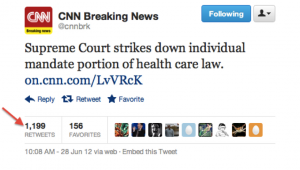
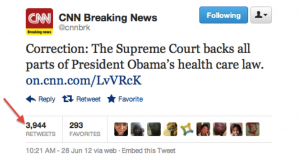
By failing to fully correct its error, Fox News added to the confusion, provided fodder for its critics, and failed to be accountable for its reporting.
Correction of the Year
This year’s winner takes the award because of the strange and incorrect initial claim, the media-on-media nature of the mistake, and the witty correction offered as a result. The winner is The Economist for this:Correction: An earlier version of this article claimed that journalists at Bloomberg Businessweek could be disciplined for sipping a spritzer at work. This is not true. Sorry. We must have been drunk on the job.The above also deserves mention because Businessweek editor Josh Tyrangiel also drew attention to The Economist’s incorrect assertion on Twitter, which added even more humor to the mistake:
According to @TheEconomist, @BW is leading the new journalism temperance movement. We will have... VENGEANCE! econ.st/P76Dx1
Most Viral Correction
There’s another correction that deserves special recognition. It was published on December 30 of last year, thus making it a 2011 correction. (I noted it on January 2, 2012.) But it took until early January for it to attract attention and ultimately prove to be the most viral correction of 2012.From The New York Times:
An article on Monday about Jack Robison and Kirsten Lindsmith, two college students with Asperger syndrome who are navigating the perils of an intimate relationship, misidentified the character from the animated children’s TV show “My Little Pony” that Ms. Lindsmith said she visualized to cheer herself up. It is Twilight Sparkle, the nerdy intellectual, not Fluttershy, the kind animal lover.Jim Romenesko played a big part in helping spread the correction thanks to a January 6 post that offered the interesting backstory.
Other Favorites
San Francisco Chronicle:
C.W. Nevius’ column about Most Holy Redeemer banning drag queen performers incorrectly stated that entertainer Peaches Christ appeared at an event at the church’s hall with a dildo shaped like a crucifix. He did not appear at the event, nor does he use the prop.The Atlantic:
This post originally referred to Jennifer Grey as “Ferris Bueller’s sister.” As commenters have pointed out, her role alongside Swayze in Dirty Dancing is clearly the more relevant. We regret putting Baby in a corner.Vogue magazine:
Full Vogue correction on mistakingly calling Assist Scy of State Dan Baer an interior designer. pic.twitter.com/2veYu1zv
I misspoke this evening on the Special Report panel. I suggested that Godzilla was less destructive than King Kong. And everyone knows that it’s the other way around. I apologize for any offense to the Kong family or to Godzilla’s fans — or victims.New York Times:
An article on Sunday about the diplomatic life of J. Christopher Stevens, the American ambassador to Libya who was killed in an attack there last week, referred incompletely to an account Mr. Stevens gave of a meeting between Cécilia Sarkozy, then the wife of the French president, with the Libyan dictator Col. Muammar el-Qaddafi in 2007. While Mr. Stevens passed along gossip that said Qaddafi had opened his robes during the meeting and was naked underneath, the former Mrs. Sarkozy, now Mrs. Attias, says that Mr. Stevens was not at the meeting and that the anecdote he repeated is not true.New York Times:
The article also misidentified the country in which Mr. Stevens served with a former diplomat, John Bell. They were in Egypt, not in Syria.
An earlier version misstated the term Mr. Vidal called William F. Buckley Jr. in a television appearance during the 1968 Democratic National Convention. It was crypto-Nazi, not crypto-fascist. It also described incorrectly Mr. Vidal’s connection with former Vice President Al Gore. Although Mr. Vidal frequently referred jokingly to Mr. Gore as his cousin, they were not related. And Mr. Vidal’s relationship with his longtime live-in companion, Howard Austen, was also described incorrectly. According to Mr. Vidal’s memoir “Palimpsest,” they had sex the night they met, but did not sleep together after they began living together. It was not true that they never had sex.Wall Street Journal:
Talking about performing in the musical “The Who’s Tommy,” the actor and singer Michael Cerveris said, “I couldn’t sing it all when I got the job.” An article on Mr. Cerveris in the latest Friday Journal incorrectly quoted him as saying, “I couldn’t sing at all when I got the job.”The Guardian:
In an article about the numbers of gay members of the Conservative party, Evan Davis, the author, referred to remarks by Ben Fenton, the FT journalist. This was an error: Davis had intended to quote Ben Furnival, the former chairman of the lesbian, bisexual, gay and transgender group ParliOut. We are happy to point out that Fenton made no contribution to this article and that Davis would have had no reason to include him as Fenton is neither gay nor has he ever given any public indication of his political leanings. The Guardian regrets the error (Glad to be Tory, 21 April, page 37, Weekend).The Globe And Mail:
François Mitterrand, the former French president, is reported to have said that Margaret Thatcher had the mouth of Marilyn Monroe and the eyes of Caligula — not Stalin, as reported in an earlier version of this article.The Australian:
Due to a production error, a quote attributed to Lieutenant Colonel Ghulam Jehlani Shafiq in a report in The Weekend Australian on Saturday (“Afghanistan battles scourge of corruption”, page 16) was altered to change its meaning. Colonel Jehlani did not say: “It’s not like 25 years ago. I was killing everybody.” In fact, he said: “It’s not like 25 years ago I was killing everybody. At that time too we tried not to have civilian casualties.” The Australian apologises for the error.Slate:
In a March 2 “Future Tense” blog post, Torie Bosch misspelled the science fiction award won by writer Bruce Sterling. It is of course the Hugo Award, not the Huge Award.The Guardian:
In an analysis piece – A shipwreck at this time in the life of Italy is almost painfully metaphoric, 19 January, page 18 – our English rendering of an Italian journalist’s blog comment contained a slip. ‘Italy,’ we had her saying, ‘is once again the laughing stocking of foreign newspapers.’Slate:
In an April 30 “TV Club,” Julia Turner misstated when Sally Draper ate the fish in Mad Men. It was before she saw the blow job.New York Times:
A Lens column earlier this month about introverts and extroverts misquoted the French philosopher Jean-Paul Sartre. The correct quote is “Hell is other people,” not “Hell is other people at breakfast.”The Economist:
In “The value of a good editor” (January 7th), we unwittingly proved the point of the title by referring to Joshua Rosenthal of the University of Puerto Rico subsequently as “Ms Rosenthal”. The gender-identifying appellation had been intended for his colleague, Sandra Garrett. Apologies to both.Miami Herald:
A column by Glenn Garvin on Dec. 20 stated that the National Science Foundation “funded a study on Jell-O wrestling at the South Pole.” That is incorrect. The event took place during off-duty hours without NSF permission and did not involve taxpayer funds.
Apology of the Year
In September, U.K. tabloid The Sun issued a front page apology for the false accusations it made in 1989 related to the Hillsborough disaster that killed 96 soccer fans and injured more than 700 in England.Kelvin MacKenzie, the editor of The Sun in 1989, also issued a personal apology for publishing the mistaken story and the related front page. Below is the original front page (left) and the one from 2012 with the apology:
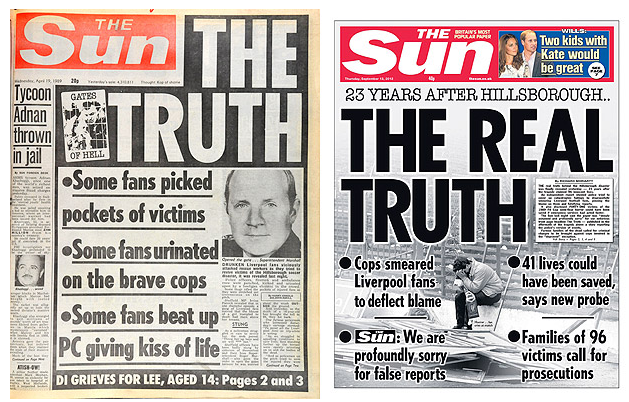
Full text of the apology:
THE Sun’s reporting of the Hillsborough tragedy 23 years ago is without doubt the blackest day in this newspaper’s history.Runner Up
The Hillsborough Independent Panel’s report into the disaster lays bare the disgraceful attempt by South Yorkshire Police to hide their culpability behind a smokescreen of lies.
It highlights a concerted campaign by senior officers to smear the innocent by fabricating lurid allegations about Liverpool fans — and then feeding them to the media.
But it is to the eternal discredit of The Sun that we reported as fact this misinformation which tarnished the reputation of Liverpool fans including the 96 victims.
Today we unreservedly apologise to the Hillsborough victims, their families, Liverpool supporters, the city of Liverpool and all our readers for that misjudgment.
The role of a newspaper is to uncover injustice. To forensically examine the claims made by those who are in positions of power.
In the aftermath of the Hillsborough tragedy we failed.
The Daily Mirror (U.K.):
WITH Saturday’s Daily Mirror we distributed a supplement entitled ‘Women who Kill’ which we trailed on the front page of the newspaper with a picture of the front page of the supplement.Other Favorites
One of the women whose story featured in the supplement was Vera Renczi who lived in the former Yugoslavia between 1903 and 1939 and who killed 35 men. Unfortunately due to an error the picture we used, both inside and on the front page of the supplement, was not of Vera Renczi but of Patricia Belda Martinez, who is otherwise known as Morgana and who is a fashion model. The picture we used belongs to Ms Martinez.
We apologise unreservedly to Ms Martinez for our error in wrongly using her picture in the supplement which she, of course, has no connection with and for the considerable embarrassment caused to her by our actions.
Mail on Sunday:
In an article that appeared in the print edition and online version of the Mail on Sunday on 7 August 2011, it was suggested that according to Mail on Sunday sources Société Générale, one of Europe’s largest banks, was in a ‘perilous’ state and possibly on the ‘brink of disaster’.Daily Star (U.K.):
We now accept that this was not true and we unreservedly apologise to Société Générale for any embarrassment caused.
IN our article “Mum blasts Lewis for abandoning baby” published on Sunday, January 8, 2012 we said that darts world champion Adrian Lewis had not paid a penny towards the upbringing of his daughter since separating from her mother and that he had effectively disappeared and abandoned her.The Sun (U.K.):
We accept that this is untrue. In fact Mr Lewis has made regular and substantial payments to his ex partner and has tried to maintain a relationship with his daughter.
We sincerely apologise to Mr Lewis for any distress or embarrassment our article may have caused.
An article on January 30 incorrectly stated that Graham Westley, Manager of Preston North End FC, had sent a bizarre late night text telling players to prepare for a 9/11 style terror attack and encouraging reaction to it.Daily Mirror (U.K.):
We accept that Mr Westley sent no such text to players or otherwise. We are happy to set the record straight and apologise to Mr Westley and Preston North End FC.
Following our article of 1 May 2012 in which it was reported that Lyn Paul of the New Seekers was a “conquest” of Tony Blackburn, Ms Paul has contacted us to say that she merely shared a dinner date with Tony Blackburn and neither slept with him nor had a relationship with him. We are happy to make this clear and apologise to Ms Paul for any upset caused.Metro (U.K.):
Metro and other publishers yesterday told the High Court they had paid substantial damages to an Algerian man for wrongly reporting that he offered a safe house in France to British al-Qaeda terrorists.
Associated Newspapers, the publisher of MailOnline and Metro; The Telegraph Media Group; MGN, the publisher of the Daily Mirror; and the publisher of the Daily Express apologised to Farid Boukemiche, 40. Some reports said he was on trial in France in January 2011 for associating with a known terrorist organisation and for financing terrorism. Others alleged he was a ‘gangster’ accused of carrying out robberies or had admitted to robbery.
The High Court heard the articles had been withdrawn from the newspapers’ websites, that they had accepted that the allegations were untrue and they had apologised to Mr Boukemiche.
Typo of the Year
The Charlotte Observer reported that an NBA player suffered a “herniated dick“: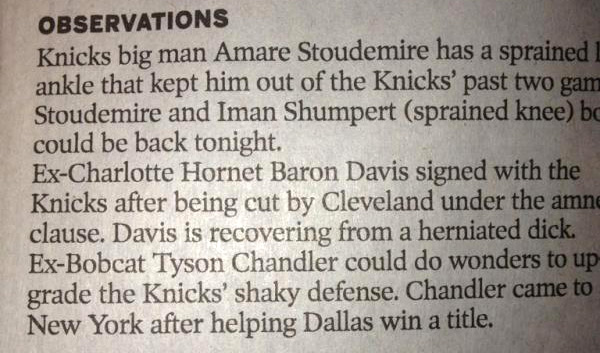
Runner Up
The Toronto Sun misspelled the word “correction” in a correction note:
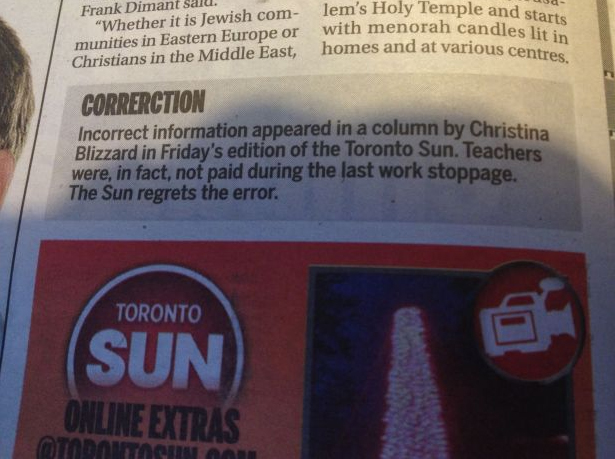
The Sun also misspelled Monday on its front page this year.
Other Favorites
The Ottawa Citizen (Canada) reported that the Titanic sank in 2012:
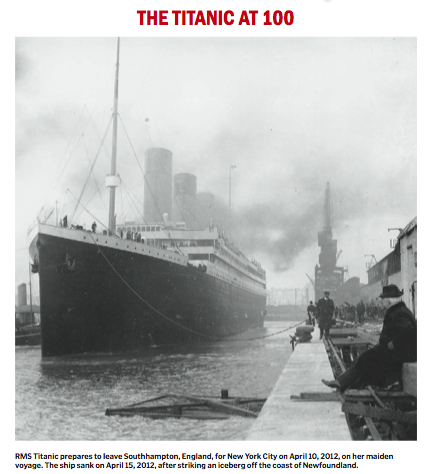
Also from Canada, the Hamilton Spectator confused a restaurant’s name with a form of cancer (the restaurant’s name is Sarcoa):
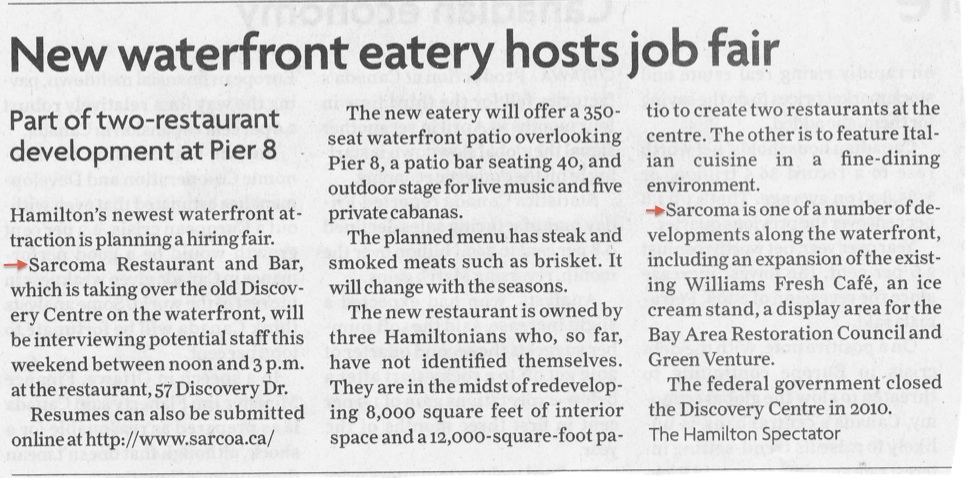
For a look at other typos of 2012, read this Atlantic piece.
Retraction of the Year
The year’s most notable, and downloaded, retraction belongs to “This American Life.” In January it aired an episode, “Mr. Daisey and the Apple Factory,” that featured performer Mike Daisey delivering a monologue about a trip to China and the working conditions of the people who make the Apple devices so many of us covet.The original episode proved very popular. It was also filled with fabrications.
Daisey made false claims about what he did and saw while in China, claims that were not caught by TAL during its checking process. After a reporter with “Marketplace” revealed Daisey’s lies, TAL set to work putting together a new show, “Retraction.”
It featured a lengthy conversation between TAL host Ira Glass and Daisey, a segment with the reporter who uncovered Daisey’s fabrications, and a look at working conditions in China.
Daisey was initially unapologetic and justified his lies. He eventually apologized.
In the end, “Retraction” attracted the largest audience for any TAL show ever in its first week of availability, and generated massive press coverage.
Best Headline Error
From the Suffolk Journal of Suffolk University (via Romenesko):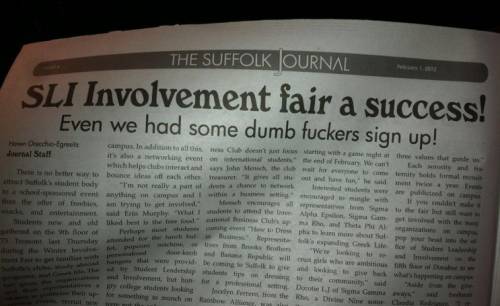
Runner Up
From the Daily Mail’s website:
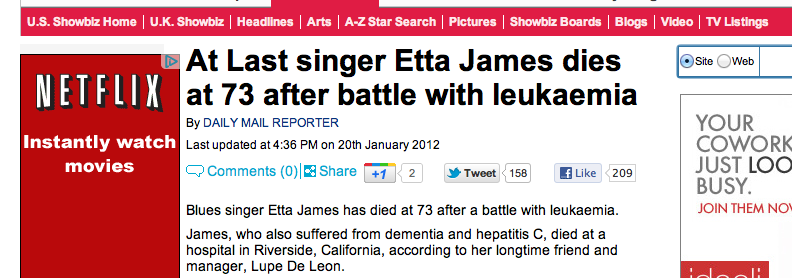
Best Numerical Error
In January, CNN’s “Early Start” was all set to do its “Wake ‘Em Up” segment with comedian Chuck Nice. They rang him up a little after 6:30 a.m. his time. But it wasn’t Nice on the line. Ruh roh. Video via Mediaite:Runner Up
New York Times:
Correction: An earlier version of this article misidentified the number of years E.B. White wrote for The New Yorker. It was five decades, not centuries.
Best Hoax
2012 was a competitive year for hoaxes.There were many of note: the fake Bill Keller column from WikiLeaks, the teenager who fooled CNBC, the fake Army sniper who fooled “Marketplace,” the paper that got fooled by a contributing cartoonist, the amusing “Abraham Lincoln invented Facebook” hoax, and of course all of the hoax photos during Hurricane Sandy. (I’ll dig a bit deeper into what the increase in hoaxes means in my forthcoming post about the trends of note from 2012.)
But the most elaborate hoax was executed by Greenpeace. The target was oil giant Shell. Greenpeace’s hoax involved a faked viral video, misleading emails to media outlets that covered the fake video, two fake Twitter accounts, and an elaborate fake website. This was a multi-layered, well-planned hoax meant to repeatedly ensnare the press. Poynter’s Jeff Sonderman broke down the Shell Arctic hoax and tried to explain its layers:
Not only was the video fake, but journalists who wrote about the video received followup emails (also fake) from “Shell” calling the video a hoax and directing them to a company website. But that Arctic Ready website, it turns out, was yet another hoax.
So, activists produce a fake viral video, get journalists to write about it, send journalists a fake email admitting the video hoax but steering them to yet another Web hoax.
Best Photo Error
A Denver TV station used a doctored photo to illustrate a story about the David Petraeus resignation/affair:
Paula Broadwell’s book about David Petraeus was “All In,” not “All Up In My Snatch.”
Best Error Report
After Washington Post writer Dennis Drabelle published a story with an incorrect fact about the sinking of the Titanic, he heard about it via unusual means. First, the error report came by snail mail. Even more notably, the letter itself was more than five feet long.“Based on our research,” wrote the kids in Mrs. Reed’s fifth-grade class at Burning Tree E.S. in Bethesda, Maryland, “the Titanic hit the iceberg shortly before midnight on April 14, 1912.” Not on the 15th, as Drabelle had written.
The Post soon published a story about the correction letter, including a photo of Drabelle holding up the request for correction:
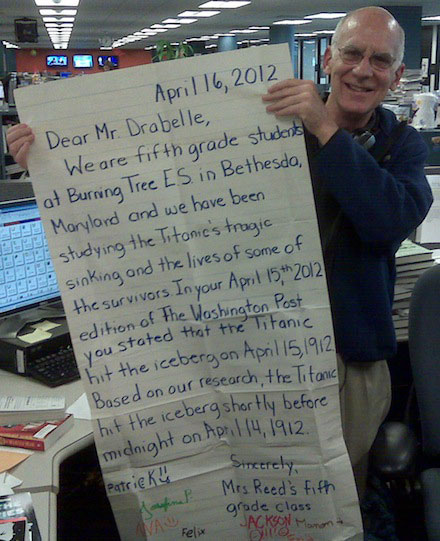
Best Explanation of Missing Information
A young journalist for Louisiana’s Rayne Independent was frustrated after not getting all the information he wanted at the end of a local softball game. So in jest he noted in his copy that stats weren’t available for a specific player due to a coach’s “bullshit and laziness.”And of course it made its way into print:
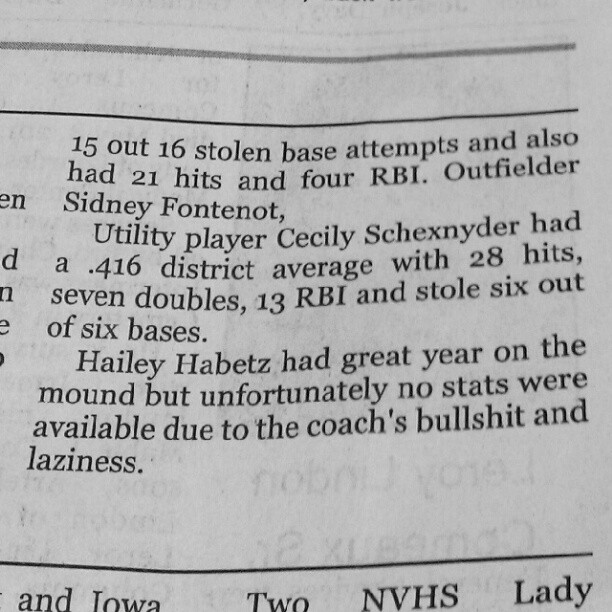
It was funny to see and to read about, but the reporter in question soon lost his job and regretted what he’d done:
17 May 12I present the world's greatest piece of print journalism ever. instagr.am/p/KvZGZAHOqA/
@JL_Reports This is still haunting me. It will haunt me for a long time. I just wish in time i can be forgiven by everyone
Worst Explanation for Fake Story
The Daily Mail’s website, MailOnline, made frequent appearances in “Regret the Error” this year. There was the above mentioned Etta James headline flub and Société Générale apology, the time it plucked a fake photo from Facebook and reported it as true, and the time it was caught stealing the work of news outlets and bloggers. (There were other posts, as you can see here.)But perhaps the most notable example from MailOnline this year was when one of its online reporters couldn’t explain how a false report about a dentist who pulled all of her ex-boyfriend’s teeth in revenge ended up on its website.
“I’ve drawn a bit of a blank,” MailOnline journalist Simon Tomlinson told msnbc.com (now NBCNews.com) for its story about how the hoax story spread far and wide.
“The (Daily) Mail Foreign Service, which did the piece for the paper, is really just an umbrella term for copy put together from agencies. My news desk isn’t sure where exactly it came from.”
Maybe that’s a nice reminder to end with: if you don’t know where the story came from, don’t publish it.





No comments:
Post a Comment